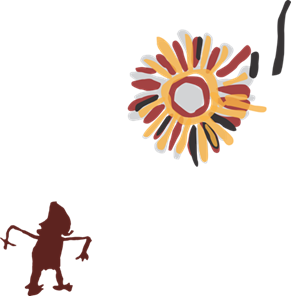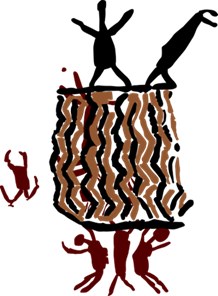Chamada para Dossiê Estéticas da Arqueologia: diálogos mediados por imagens rupestres

Figura 1
Chamada de artigos Artefilosofia
Editor/as do Dossiê:
Carla Milani Damião (UFG)
Rogério Tobias Junior (UFMG/Instituto Prístino)
Celina Lage (Escola Guignard-UEMG)
Lílian Panachuk (UFMG)
Data limite para submissão: 20/12/2025
A proposta deste dossiê é de ultrapassar uma relação meramente multidisciplinar entre Estética e Arqueologia. Visa estabelecer canais de troca e maneiras particulares de vivenciar grafismos rupestres, experiências individuais e coletivas com tais materialidades e fazeres a partir de convergências, sobreposições, justaposições e temporalidades específicas destes campos. Esse diálogo parte de duas experiências curatoriais recentes (Pedras Pintadas no Centro Cultural UFG em Goiás, 2024 e Grafismos na Pedra: as artes rupestres brasileiras no Museu de História Natural e Jardim Botânico da UFMG, 2024/2025, em Minas Gerais).
Da Filosofia e da Estética recolhemos muitas metáforas de teor metodológico que recorrem à Arqueologia e suas interfaces com a Paleontologia (Merleau-Ponty, O visível e o invisível, 2003) ou a Geologia (Benjamin, “Nápoles”, 2023; “Escavar e recordar”, 2017). Métodos que requerem voltar ao tempo histórico em profundidade, gerando imagens que se aproximam de práticas de escavação, da materialidade e da corporeidade. Ao tomarem a Arqueologia como modelo, filósofos e estetas afastam-se das categorias e modelos artísticos que condicionam teorias estéticas normativas e aproximam-se da qualidade do estético que permeia nosso cotidiano através dos tempos e lugares. Das categorias normativas das estéticas modernas submetidas à severas críticas, tendo em vista seus valores e juízos etnocêntricos europeus (McDonald and Veth, 2012), poucas permanecem nessa nova perspectiva, entre as quais a certeza de que a “percepção” (do grego aisthesis) é um termo comum e de profundo enraizamento nas pesquisas de uma área e da outra.
Da Arqueologia, em suas interfaces com a Antropologia, Etnologia e História, trazemos expectativas acerca da forma, tão tradicionalmente considerados a partir de categorias étnico-culturais ou estilísticas. Vislumbramos aspectos outros, parcamente abordados porém francamente presentes na vida cotidiana de pesquisadores e suas pesquisas. Trata-se de uma expansão de perspectivas dadas como possíveis no estudo de imagens rupestres, a partir, por exemplo, da ênfase no processo, na performance, no movimento, no percurso, na temporalidade, e que convoca o entendimento de que pessoas e seres são coparticipantes da emersão de traços, de figuras e da produção de outros seres ou coisas por meio do ato de grafar (Linke et al, 2020). Tais perspectivas vislumbram potências coletivas que admitem lugares e coisas como vértices, e processos e movimentos como linhas que juntos entrelaçam distintos aspectos da experiência humana. Destas linhas, o fazer as coisas se apresenta como maneira de habitar o mundo e engajar-se nele: da pessoa que grafa à pessoa que indaga o que se grafa/grafou, técnica e tecnologia colocam-se como meios para experimentar e experienciar tais processos, de aproximar formas de habitação distintas ou mesmo, provocar mudanças na habitação contemporânea (Ingold, 2013). Da percepção em campo que envolve movimentos e gestos corporais, seja no alcance territorial, na experiência do fazer ou na documentação de imagens rupestres, seja na captura ou no processamento digital das imagens em laboratório, à exposição pública de seus resultados, percebemos no trabalho mediador da Arqueologia uma complexidade que não está alheia aos procedimentos originados da experiência estética.
A estética é precisamente o campo que combina essas múltiplas formas de abordagem, reunindo cognição, sensação, imaginação, afeto e corporeidade (Roelofs, 2025) na relação que se estabelece com a experiência, na forma de endereçamento recíproca e mediada das imagens captadas, processadas e difundidas. As perspectivas dos povos originários vêm impactando de forma contundente o fazer arqueológico e subvertendo as noções ocidentais de patrimônio, arte e tecnologia, enfatizando a dinâmica, a humanidade, a animalidade e tensionando dicotomias hegemônicas. Neste mesmo caminho, perspectivas afrocentradas se debruçam sobre diferentes questões tradicionais e lançam novas provocações para pensar arqueologia, apontando novas metodologias e conceitos, trazendo relacionalidade, posicionalidade e corporalidade. O entendimento de uma ciência situada, trouxe à baila desejos de novas produções de imagens, novos repertórios, novas narrativas.
A arqueologia, então, vem se tornando permeável a aspectos antes descartados, assumindo ser afetada, envolvimentos e correspondências que permitem compreendê-la como outra forma de habitação, trazendo a estética para um jogo antes dominado pela objetividade e pela generalização. Propomos como tema desse dossiê uma estética da arqueologia como possibilidade de reunir aspectos confluentes entre as áreas, porém, respeitando as marcas distintivas de suas funções e finalidades. Visamos, sobretudo, ao mostrar as afinidades, desfazer preconceitos normativos e recorrer à normatividade possível ou à necessária, de forma refletida e responsável.
Serão aceitos textos originais, produções imagéticas, entrevistas, traduções e resenhas, até 05 de outubro de 2025 e enviadas para a seção 'Estéticas da arqueologia'. Os subtemas abaixo visam nortear discussões para a proposição de artigos a serem submetidos.
Subtemas:
- Imagens rupestres, tradições e a questão do estilo;
- Experiência estética em campo: percepção, sensação, imaginação e cognição;
- Aspectos tecnológicos do fazer rupestre: performance, gesto e traço, aplicadores, tintas e outros dispositivos;
- Efemeridade e sobrevivência das imagens (pinturas e gravuras) sobre as rochas;
- Finalidade da forma e forma final;
- Teorias da imagem e uso de metáforas relacionadas à prática arqueológica;
- Da pesquisa e do campo à exposição;
- Produção de mediadores analógicos e digitais;
- Curadoria: seleção, endereçamento ao público e exibição;
- O que restou na reserva técnica?
-----
Aesthetics of Archaeology Dossier: Dialogues Mediated by Rupestrian Images
Call for papers Arte Filosofia
Editors:
Carla Milani Damião (UFG)
Rogério Tobias Junior (UFMG/Instituto Prístino)
Celina Lage (Escola Guignard-UEMG)
Lílian Panachuk (UFMG)
Deadline for submission: 20/12/2025
The aim of this dossier is to go beyond a merely multidisciplinary relationship between Aesthetics and Archaeology. It seeks to bridge modes of exchange and particular ways of experiencing rock art, individual and collective experiences with such materialities and practices based on convergences, overlaps, juxtapositions, and specific temporalities in both fields. This dialogue is based on two recent curatorial experiences (Pedras pintadas/Painted Stones at the UFG Cultural Centre in Goiás, 2024 and Grafismos na Pedra: as artes rupestres brasileiras/Graphisms on Stone: Brazilian rock arts at the UFMG Museum of Natural History and Botanical Garden, 2024/2025, in Minas Gerais).
From Philosophy and Aesthetics, we gather many metaphors of methodological content that draw on Archaeology and its interfaces with Palaeontology (Merleau-Ponty, The Visible and the Invisible, 2003) or Geology (Benjamin, "Naples", 2023; "To excavate and to remember", 2017). Methods that require returning to historical time in depth, generating images that approximate excavation practices, materiality, and corporeality. By taking Archaeology as a model, philosophers and aesthetes move away from the artistic categories and models that condition normative aesthetic theories and approach the quality of the aesthetic that permeates our daily lives through times and places. Of the normative categories of modern aesthetics subjected to severe criticism, given their European ethnocentric values and judgments (McDonald and Veth, 2012), few remain in this new perspective, among which is the certainty that "perception" (from the Greek aesthesis) is a common term and of deep roots in the research of one area and the other.
From Archaeology, in its interfaces with Anthropology, Ethnology, and History, we bring expectations about form, so traditionally considered from ethno-cultural or stylistic categories. We glimpse other aspects, sparsely addressed but frankly present in the daily lives of researchers and their research. It is an expansion of perspectives given as possible in the study of rupestrian images, from, for example, the emphasis on process, performance, movement, path, temporality, and that calls for the understanding that people and beings are co-participants in the emergence of traces, figures and the production of other beings or things through the act of writing (Linke et al, 2020). Such perspectives glimpse collective powers that admit places and things as vertices, and processes and movements as lines that together intertwine different aspects of human experience. Of these lines, making things presents itself as a way of inhabiting the world and engaging in it: from the one who writes to the one who asks what is written/was written, technique and technology are placed as means to experience such processes, to approximate different forms of habitation or even, to provoke changes in contemporary habitation (Ingold, 2013). From the perception in the field that involves bodily movements and gestures, whether in the territorial scope, in the experience of making or in the documentation of rupestrian images, whether in the capture or digital processing of images in the laboratory, to the public exhibition of their results, we perceive in the mediating work of Archaeology a complexity that is not alien to the procedures originated from aesthetic experience.
Aesthetics is precisely the field that combines these multiple forms of approach, bringing together cognition, sensation, imagination, affect and corporeality (Roelofs, 2025) in the relationship that is established within experience, in the form of reciprocal and mediated addressing of the captured, processed and disseminated images. The perspectives of indigenous peoples have been strongly impacting the archaeological work and subverting Western notions of heritage, art and technology, emphasizing the dynamics, humanity, animality and tensioning hegemonic dichotomies. In this same way, Afro-centred perspectives focus on different traditional issues and launch new provocations to think about archaeology, pointing to new methodologies and concepts, bringing relationality, positionality and corporality. The understanding of a situated science brought to the fore desires for new productions of images, new repertoires, new narratives.
Archaeology, then, has become permeable to aspects previously discarded, assuming to be affected, involvements and correspondences that allow us to understand it as another form of inhabitation, bringing aesthetics to a game previously dominated by objectivity and generalization. We propose, as this dossier’s theme, an aesthetics of archaeology as a possibility to bridge confluent aspects between the areas, however, respecting the distinctive marks of their own tasks and purposes. We aim, above all, by showing the affinities, to undo normative prejudices and resort to the possible or even necessary normativity, in a careful and responsible way.
Original texts, image productions, interviews, translations and reviews will be accepted by October 5th, 2025, and should be submitted to the 'Aesthetics of Archaeology' Section. The subtopics below aim to guide discussions for authors before articles’ submission.
Subtopics:
- Rupestrian images, traditions and the question of style;
- Aesthetic experience in the field: perception, sensation, imagination and cognition;
- Technological aspects of rupestrian image making: performance, gesture and line, applicators, inks and other devices;
- Ephemerality and survival of images (paintings and engravings) on rocks;
- Purpose of form and final form;
- Theories of image and use of metaphors related to archaeological practice;
- From the research and field work to exhibition;
- Production of analogic and digital mediators;
- Curatorship: selection, addressing to the public and exhibition;
- What remained in the technical reserve?

Figura 2
----------
Figura 1: Figura antropomórfica do sítio arqueológico GO-CP-06 em Palestina de Goiás-GO, vetorização Carla M. Damião composta com Círculo Radiado do sítio Lapa do Sol de Jequitaí - MG, vetorizada por Rogério Tobias Jr.
Figure 1: Anthropomorphic figure from the archaeological site GO-CP-06 in Palestina de Goiás-GO, vectorized by Carla M. Damião, composed with Radiated Circle from the Lapa do Sol site in Jequitaí-MG, vectorized by Rogério Tobias Jr.
Figura 2: Sítio Arqueológico Lapa da Mamoneira-MG, vetorizada por Rogério Tobias Jr.
Figure 2: Lapa da Mamoneira-MG Archaeological Site, vectorized by Rogério Tobias Jr.

